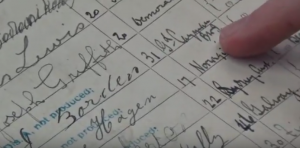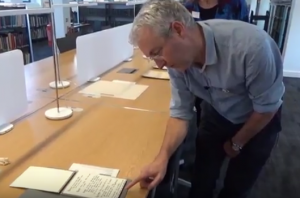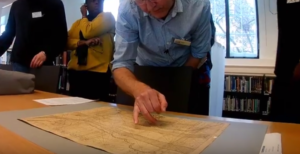A special addition to the UKOTA and Maritime Museum OT student conference this year was a fascinating tour around some historical artefacts sourced by the Maritime Museum held at the Caird Library within the Museum.
Below you can learn about the artifacts put together for the conference, and descriptions about each item in relation to each territory.
Watch first hand the description of the artifacts, in the video produced by Benson Williams of BTSW Productions.
WATCH THE VIDEO OF THE OT ARTIFACTS EXHIBITION… with thanks to BTSW Productions.
Gibraltar
- ADM/Y/G/1 Plan of Gibraltar 1704, (the year the territory is taken from Spain). As well as the Rock and Straits are shown Tangier, as ‘part of Barbarie’
- JOD/281: James Spratt recovering in the Gibraltar naval hospital after the battle of Trafalgar [passages concerning his single handed boarding of the French ship L’Aigle and his ‘recovery’ in Gibraltar hospital are marked with paper slips]
Virgin Islands
Two maps from the collection of William Grenville, (Foreign Secretary and later Prime Minster).
- GREN80/A2 The first map of 1775 shows Tortuga and the surrounding islands (Virgin Islands). They are coloured according to which European power owns them, suggesting they are to be ceded to Britain as part of the Peace treaties- the Dutch and French at the end of the war of Independence. Also notes on the nearby Spanish territories (where the English have been ejected twice!).
- GREN80/A3 Map of the island of Tortuga (Virgin Islands). In the previous century it had been a haven for pirates (and still shows buried treasure!), by 1798 it had been the subject of a land grab- the whole island is given over to 104 plantations, growing cotton and sugar with slave labour. Isaac Pickering is the largest landowner, closely followed by the heirs of R Hodge. Public or Crown land has been reduced to a tiny strip near the harbour- even the older forts are on private land.
Bermuda
- Plan of the dockyard at Bermuda, c.1898, showing the whole island is occupied by the Admiralty. Various storehouses and workshops predominate but also the separate living quarters for the married offices can be seen, along with the floating dock (very important base for the North American station- the only floating dock in that hemisphere).
Pitcairn Island (last British oversea territory in the Pacific)
- Bounty’s Medical text book PBD6069 (613.094) William Buchan’s Domestic Medicine- Ships copy taken by the mutineers from HMS Bounty in 1789. General medical textbook showing how to set broken bones, cures for toothache, headache, treatment of scurvy, even childbirth. But not a scientific book- no illustrations of medical instruments. The passions- Fear, anger, Love (and value of physicians)
Falklands
- LWN/1/25 Admiral of the Fleet Terry Lewin- Mrs Thatcher’s Chief of Defence staff during the Falklands conflict- involved in the changes to the Rules of Engagement to torpedo the Argentinian warship General Belgrano (heading away from the exclusion zone) and Chairman of Trustees during of the NMM until 1999. This is Lewin’s personal notebook- from the time- but the green handwriting is in shorthand and very hard to read- described by his biographer Richard Hill as ‘dynamite’.
Grand Cayman islands
- RSS/CL/1915/4008/007 Crew list of the Chile merchant ship from 1915. Halfway down the second page is a sailor from the Grand Cayman islands, named Joseph Borden. Many nationalities are represented on the crew list- Norway, Sweden, Dutch East Indies- and Liverpool. 5 names from the list are recorded as ‘Deserted’ or ‘Arrested’ at Pensacola in the Gulf of Mexico. The records offer this clue only into what happened when the Chile called at Pensacola….
MORE STUDENT INTERVIEWS AT THE SPECIAL EXHIBITION:
Participants from Turks & Caicos Islands (TCI) , British Virgin Islands (BVI) and the Cayman Islands (CI) were also interviewed, abbreviated transcripts are below:
Were there any artifacts in particular that really caught your interest?
TCI – I really found the Medical Text book interesting, it is so rare to see something that shows the processes of medical history and the medical cures they used in those times, when it was hard to find a doctor.
BVI – Definitely the map of the British Virgin Islands, especially the one of Tortola showing the different plantations and land ownership of the time.
CI – I found all articles interesting sitting together showcasing a shared history of the OTs, I loved the diary James Spratt, we all dream and have ideas of the era of ‘pirates’ and this was fascinating to read! The most interesting to me, naturally however, was the Crew list of the Chile merchant ship.
And what was it about that artifact that particularly interested you?
TCI – I thought the reporting of the natural ingredients used for medicine was particularly interesting in comparison to todays medicine which is so chemical focused.
BVI – I was particularly interested in this because of my last name, Pickering! It was a map showing all the land owned by Isaac Pickering, the largest landowner of the time, and some of the other plantation owners, it really gave a good insight about the different settlers we had in Tortola, related to family names, and we can see from the map and through these families names, that today in Tortola people have stayed relatively close to where their ancestors grew up.
CI – I loved this as a real record of someone from Cayman being on a crew list record from 1915 – not as old as some of the other artifacts in this collection, but Cayman’s own history in terms of human settlement is short so that’s to be expected. It was great to see the Bordon name, one that is still around in Cayman we think of ‘Bordon’s Pizza’! Also a derivative of the name Bordon is Bodden, which is a common surname in Cayman.
Are there any particular similarities or differences that you can identify about the OTs based on these artifacts, or between OTs then and OTs now?
TCI – Well using the medical book as an example I see many similarities in the way we seek medical attention, and differences in what medical advise is given, but in relation to the Turks and Caicos Islands you still have people who use ‘bush medicine’ herbal remedies and ‘bush tea’ so there are certainly similarities there.
BVI – It is great to see all of these artifacts here, across so many Territories, there seem to be a few territories missing, but we now understand about that from Dr Blyth’s talk from this morning. It is really great to see these artifacts side by side representing the similarities and differences of the OTs through history.
CI – It is really interesting to see the various artifacts throughout history, the maritime based similarities obviously are the core theme here, so the maritime similarities are the most prevalent in this collection, however the similarities of settlement, and names carried through generations is shown across a number of these artifacts as well.
What does it mean to you to have a shared maritime history with the OTs?
TCI – It allows us to connect with other Overseas Territories on a different level, we know we have a shared maritime history but often don’t know much more about the other territories so it presents an opportunity to learn more about the other territories through this strand that brings us together.
BVI – In terms of the shared maritime history we know that the Caribbean played a vital role within the history of trade, including the transatlantic slavery trade and material goods trade, so that in itself gives us the bond of history, as well as the fact that all of us are surrounded by water, well, that’s simple!
CI – I think connecting with other OTs through a mutual appreciation of the sea and our relation to it, brings us together so that we are then more open to understanding other similarities and challenges that we share, the obvious one being our relationship with the UK. There are other less obvious shared commonalities, discovering these is also the fun part, and most of us are learning these just by meeting each other on occasions like this.




Hi, I just read texts on your blog and I became interested in the topic. I like your content and I am thinking whether I could use your words in my work? Would it be doable? If yes, please contact with me. Thanks.
Thank you for the useful post! I would not have gotten this otherwise!